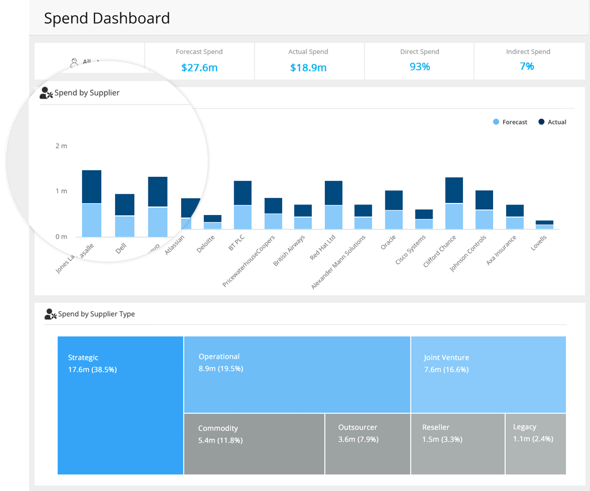“Be fearful when others are greedy and greedy when others are fearful.”
- Warren Buffett
Warren once said this is a wise approach for investors to take. I want to discuss its application to your business expenses.
This article is for budget owners, procurement strategy teams, vendor managers and controllers that want to do the following:
- Have their team’s back and maximize job security
- Have their executive’s back and be proactive in problem solving
- Have their own back, unlock spend and increase purchasing power
The Bad News
Like it or not, you should expect budgets to tighten. You will probably be asked to stay in a hold pattern until your executive team better understands its financial health. Current spend will be scrutinized heavily and, if at all possible, deferred.
The Good News
If you (like many mid-market or growth stage organizations) have not historically completed regular deep dives on spend, there is likely a bunch of savings, new spend and value creation you can actualize by focusing on efficiency.
Some Caveats Before You Get Started
For background research, I spoke with two former management and procurement consultants. These tactics have been executed successfully at an enterprise level and resulted in millions of dollars in savings.
Some of the techniques include streamlining and renegotiating contracts. That said, business is built on relationships. When approaching these situations, it's critical to look at creating win-wins. Imposing our needs unilaterally can have negative consequences and, philosophically, is not how I want to do business nor how I would want to be treated as a vendor.
Two steps for quick wins
If bandwidth does not exist to go deep, here is a playbook for quick wins.
- Simply ask your vendors for a discount for FY 2020. Be specific in your ask and give them a reason for your request.
- Ask every vendor for a copy of all active, executed contracts you and any member of your company, subsidiary or sister company has with them.
Why?
- It will save you time hunting contracts down internally
- There may be an opportunity to defragment agreements so they provide greater value due to actual scale
- If an agreement cannot be located by the vendor, this is a GREAT opportunity to re-establish terms
Moving on.
Step 1: Set Objectives
- Objective 1: Understand what you are spending money on so savings opportunities can be identified.
- Objective 2: Ensure stakeholders have easy access to this information so they can create and execute a plan.
Step 2: Collect Data
Figure out where the information lives a.k.a “follow the money.”
| Location | Spend Item |
| ERP | Direct Spend |
| AP Systems | Indirect Spend |
| Credit Cards | Maverick Spend |
| Shared Drives | Contracts |
| Email Inboxes | Contracts |
Step 3: Data Merge
This will be the most time consuming aspect. Let's start with potential support solutions.
- Get help from IT
- Get an intern to do it
- Use technology
- Outsource it cheaply
Core considerations:
So you do not get overwhelmed, and can get to a point of value quickly, you should focus on the most critical attributes for the most critical vendors including:
- Total spend
- Forecast vs actual spend
- Category of goods/services provided
- Number of active contracts
- Dates, renewals, notice periods
*For the uniform naming of categories, HS codes may be a good starting point.
Critical Vendors
This is where the 80/20 rule should come into play. The biggest wins come from the biggest numbers. Do not allow yourself to get bogged down by long tail spend. Oftentimes, the biggest challenge in this whole process is simply knowing where to start.
Additional considerations:
If you have the resources in place, these are some deeper areas you can go to:
- Payment terms
- Number of seats used vs purchased
- NPS or similar satisfaction scoring
- Pre Negotiated discounts
- Contracted price increase
- % discount attained on contract
- Force Majeure
- Contracted price breaks
Another tip – procurement works hard upfront to negotiate price breaks yet they often go unnoticed. Find these nuggets as you may be overpaying due to a lack of attention to detail. This type of insight is golden, as you could reduce cost and even potentially be owed money.
Step 4: Identify Opportunities for Renegotiation
- Consolidate vendors: Who are your top suppliers? What are you buying from them? How are they performing? What could you be buying from them?
- Consolidate agreements: Do you have any fragmented agreements you can bring together?
- Underutilized services: Best accomplished by employee survey or technology.
- Vendors with medium-high $ value that meet some/all of the following criteria:
- Low NPS Subcategory minimally disrupted by change
- Coming up for renewal
- Low/no contracted discount
- Could not locate your contract with them when asked
 Gatekeeper's Spend Dashboard
Gatekeeper's Spend Dashboard
Step 5: Create a Plan and Take Action
The final piece needs to be approached thoughtfully. To do this well, win-wins need to be created for business owners and vendors.
There are a few considerations I want to raise on negotiating best practices in this context.
- Have CXO sponsorship. These conversations can be tense and you want to be empowered during the process.
- Be sure and work in unison with the business owner of the relationship. You need to understand the impact on their day-to-day. When the right opportunity is identified, one should be able to make a compelling case on how this situation will also benefit them by unlocking their budget or allowing them to increase purchasing power elsewhere.
- Consider bringing in a third party to own this conversation (can be a member of the leadership team.) It must be clear that all comms go through this person and they cannot be circumvented. However, having someone else involved helps ensure personal relationships are not affected when returning to BAU.
- Your sales rep at x company can be an external advocate. Understand how your rep is incentivized. Can a new deal be structured that they can also get behind and push for?
- Come to the table with value for your vendor. Some ideas for you to consider:
- Who has the greater need for liquidity?
- Are upfront vs monthly payments an option?
- Be willing to commit to a longer term.
- Be willing to provide a case study or testimonial.
- Be willing to make introductions to your peers that would benefit from the service they provide.
I hope in reading this article you came away with at least 1 or 2 new ideas you can bring back to your organization. If you want to talk through any of this, get advice on putting it into practice, or discuss other strategies you have found useful, please contact me directly.
If you’re interested in a full demo of Gatekeeper’s powerful contract management solution, which is helping customers manage their spend and contracts effectively, you can book one now.

.png)
.png)
.png)
-4.png)